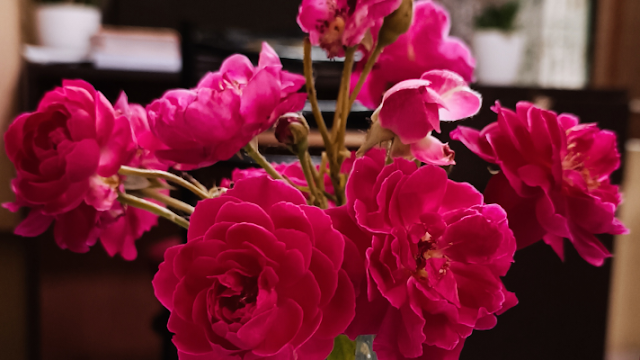Technique of producing roses
Temperature:
The temperature to produce the highest flower yield in roses is between 15 to 18°C during night and between 20 to 25°C during day. During winters, the number and quality of flowers is good because of the low temperature.
Light:
Roses require more than 12 hours of daylight to give maximum performance.
Humidity:
High humidity in the atmosphere invites pests and fungi to cause diseases. Accumulation of water droplets on the leaves for a longer duration invites mildews and other fungal diseases.
Season:
Roses can be grown round the year. Best time for plantation is during September and October in the plains and and during October to November or February to March in the hilly areas.
Preparation of soil:
The ideal soil for cultivation of roses is medium loam with sufficient organic matter and pH between 6.0 and 7.5. Soil should be with a good drainage facility. Any gravel, stones, brick pieces and other foreign materials should be removed. Expose the soil to sun for at least a week before plantation.
If the soil is light and proper drainage is there, no bed preparation is needed. But, if the soil is heavy and proper drainage is not there, raised beds (40 cm above the ground) should be prepared. For preparation of beds, pits must be dug before the onset of rain to let the soil settle down. Pits of 20-30 cm wide and 30 cm deep should be prepared and likewise the beds should also be prepared. Care should be taken that the top soil should remain on the top.
If the soil is light and proper drainage is there, no bed preparation is needed. But, if the soil is heavy and proper drainage is not there, raised beds (40 cm above the ground) should be prepared. For preparation of beds, pits must be dug before the onset of rain to let the soil settle down. Pits of 20-30 cm wide and 30 cm deep should be prepared and likewise the beds should also be prepared. Care should be taken that the top soil should remain on the top.
Distance between plant:
60 x 60 cm spacing is ideal for rose cultivation.
 |
| Roses as a flower |
Varieties:
| Main Classes | Varieties |
| Hybrid Tea | First red, Super star, Double delight, Kiss of fire |
| Floribunda | Iceberg, Allgold, Neelambari, Delhi princes |
| Polyantha | Anjani, Rashmi, Nartaki, Swati |
| Miniature | Dark beauty, Green Ice, Kale gold, Over the rainbow |
| Climber | Black boy, Delhi white pearl, Soft Silk, High moon |
Preparation of Beds:
The beds or pits are prepared at least a month before the date of planting, so that the soil gets exposed to sun and air, and during the rainy season it gets a chance to settle down. Beds are prepared to a depth of 60-75 cm. A trench of 45-60 cm broad is dug to 30 cm depth. This trench is again dug and forked. While forking a well-rotten cow dung manure and bone meal may be mixed in the soil.
Planting:
Pits of size 45 cm3 can be dugged while planting in pits. Before planting, the top 30 cm soil from the pits should be removed. While planting it is necessary to spread out the roots evenly. The soil is returned to the pit and firmed towards the center. The plant must be watered adequately after planting.
Aftercare:
The newly planted roses require frequent watering in the beginning. After that they may be watered once in five days during summer, and once in ten days during winter. If the soil is sandy, more frequent watering may be necessary. On the other hand if the soil is heavy and retentive of moisture the watering interval may have to be increased. Care should be taken to avoid stagnation of water too long as it is harmful to the roots.
Disbudding:
Some varieties produce some side buds below the center bud. These must be removed or disbudded.
Dead shoot removal:
In the old plants the dead shoots should be regularly removed.
Manuring:
At three months' interval, apply Farm Yard Manure (FYM) at 10 kg and NPK (8:8:16 g) per plant after each pruning.
Harvesting:
Harvesting is done with sharp secateurs when the petals have not yet started unfolding. There should be 1 or 2 mature leaves on the plant after the flower has been cut. New shoots will proliferate at the cut end. Harvesting is done during early morning hours.
Post harvest handling:
Harvested roses should be kept in bucket of water inside the polyhouse and then transported to cold storage (2-4°C). The flowers are graded according to the length. It varies from 40-70 cm depending on the variety and packed in 10/12 per bunch.
Content first created on 05-04-2023
last updated on 29-04-2023
last updated on 29-04-2023





0 Comments
Leave your comments here.